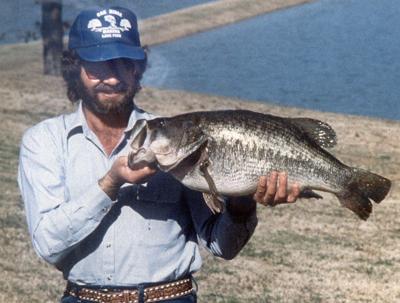Biggest Largemouth Bass Ever Caught in Texas
March 07, 2024
By: Jon Stewart
Did you know that Texas is home to more than 1.2 million acres of water?
No wonder Texas is so well-known for largemouth bass fishing! ✅
As there are literally hundreds of lakes for fishing in Texas, the state is home to a large number of aquatic animals. When in the state of Texas, ignoring all the lakes, rivers and streams will be almost impossible. Ok, it likely will be impossible.
For many years, Texas has been at the top of the list of the best fishing activity in the country. With magnificent scenery and a large population of wild animals, you can find almost any kind of fish—and the largemouth bass is no exception.
What’s the Biggest Bass Caught in Texas?
The biggest largemouth bass ever caught in Texas weighed 18.18 pounds and measured 25.50 inches. The record bass was caught on January 2nd, 1992 by Barry St. Clair.
St. Clair caught the Texas state record on Lake Fork, a massive reservoir that spans three counties. Although 38-year-old St. Clair wasn't a local, he was an experienced all-around fisherman who visited Lake Fork 3 to 4 times a week.
Here's a photo of St. Clair's monster largemouth, with the 90s style that we all miss:

What Bait was Texas’ State Record Largemouth Bass Caught On?
The largest bass ever caught in Texas was caught with a live minnow. The angler, St. Clair, said the depth was approximately 42 feet when the bass took the minnow.
St. Clair used a Berkley lightning rod and a Shimano bait reel. He used a fishing line with 14 pound test. As the bass that St. Clair caught was more than 18 pounds, this speaks to the absolute skills displayed by St. Clair in reeling the monster in. Further, the size of St. Clair's record bass speaks to the quality of bass in Texas - the biggest largemouth ever caught in Arkansas was two pounds smaller than that of Texas, for example.
Where was Texas’ Biggest Largemouth Bass Caught?
Barry St. Clair landed the 18.18-pound larry on Lake Fork near Quitman on January 24, 1992. He was fishing with live minnows as bait. According to the Texas Parks and Wildlife Service, that fish is the state record for largemouth bass. Anglers have been trying to do this ever since, including competitors in the Texas High School Fishing State Championship held at Lake LBJ in central Texas in March, where the largest largemouth bass caught there was an impressive 10 pounds, 3 ounces.
Lake Fork Reservoir is located in Wood, Raines, and Hopkins counties in Texas, between Albert, Emory, and Yantis, Texas. It has a surface area of 27,264 acres, a maximum depth of 70 feet, and was impounded in 1980. The largemouth bass is the most popular fish in Lake Fork.
The combination of restrictive logging regulations, the stocking of the local largemouth bass population, and abundant habitats contributed to the development of Lake Fork into one of the most well-known trophy bass lakes in the country. 🇺🇸 The southern United States is known to produce huge bass in large numbers, as Georgia (a nearby neighbor of Texas) is known for the world record largemouth bass, which weighed in at 22 lbs, 4 ounces.
What Has Barry St. Clair Been Up To Since His Catch?
As an avid outdoorsman, St. Clair has hunted and fished across the state of Texas for the past 28 years. He particularly likes fishing for striped bass and mixed striped bass in many Texas lakes.
At the time of writing, Barry lives in Athens, Texas with his wife, Gail, and two children. Barry has also been busy writing a book, titled Fishing Texas. This book provides anglers with a useful reference for the best fishing places in Texas, describing the necessary details that give each location its characteristics and reputation, as well as the main species and ecological regions in which they are found.
Did you like this article? Share it with a friend!